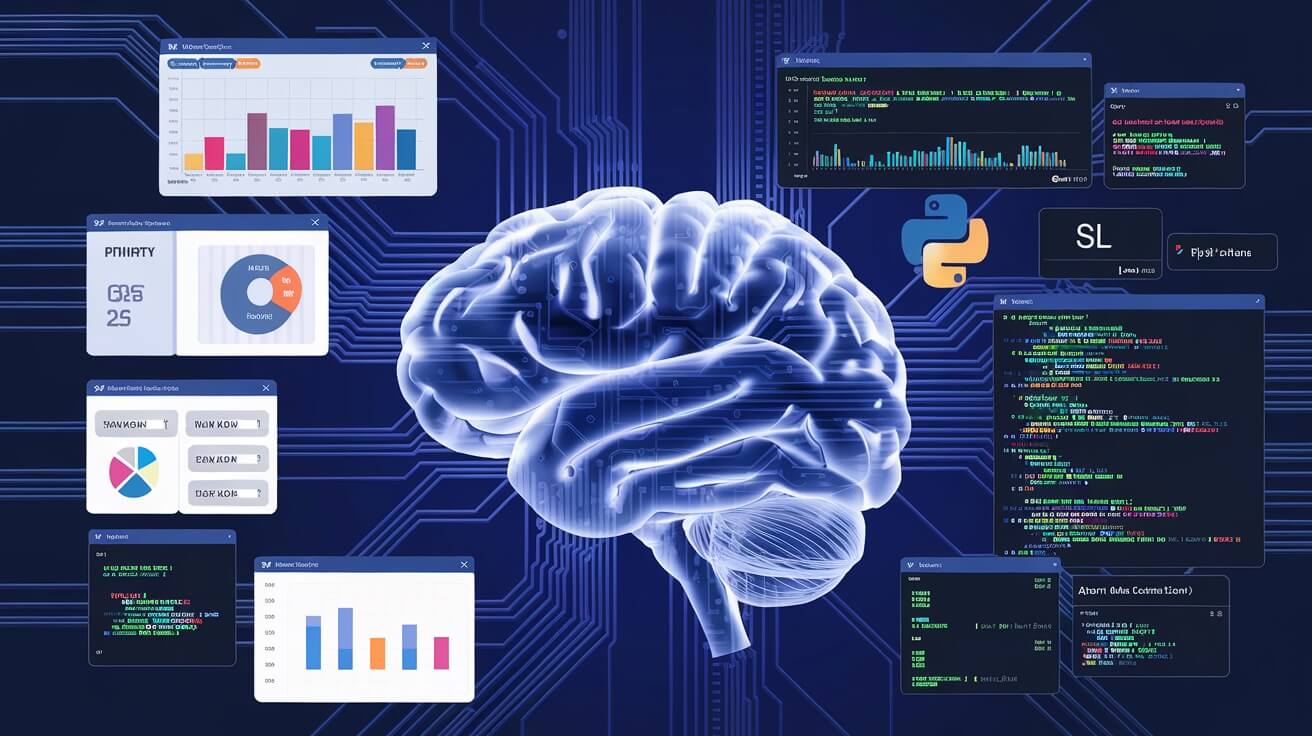
Essential Skills for Data Analysts: What You Need for Career Growth
Introduction:
Have you noticed how data drives almost everything today? Data is at the core of our world, from personalized recommendations on streaming platforms to the numbers that guide critical business decisions. And that’s why data analysts are in such high demand. They interpret, organize, and communicate these insights in ways that help businesses make smarter decisions.
But being a successful data analyst isn’t just about technical know-how. To truly excel, you need a well-rounded skill set that includes programming, problem-solving, and communication skills. This article will break down these essential skills, guide you on developing them, and explain why they matter in the industry. So, if you aim to thrive in this field or want to understand what it takes to be a great data analyst, let’s dive into this all-in-one guide.

Why Skills Matter in Data Analysis: A Competitive Edge
With businesses worldwide relying on data to make informed decisions, data analysts are in high demand. But what makes one analyst stand out from another? It’s often their skills—how they approach data, extract insights, and communicate them to teams.
According to LinkedIn’s 2023 Workforce Report, data analysis ranks among the top hard skills sought after by employers. Technology is essential, but companies also want people who can communicate and collaborate.
Blending technical expertise with strong interpersonal skills in data analysis helps you stand out as a key contributor on any team.
Core Technical Skills for Data Analysts
1. Programming Languages (Python, R, SQL)
-
Why They Matter: A data analyst’s toolkit often starts with programming languages. Python and R are famous for their versatility in data processing and statistical analysis. Python, in particular, is valued for its easy syntax and broad libraries that simplify data manipulation.
-
SQL Essentials: SQL (Structured Query Language) is the go-to for database management and data extraction. It’s common to use SQL for pulling data from relational databases, and most job postings list SQL as a fundamental requirement.
-
Example in Practice: Suppose you’re working for a retail company and must analyze customer purchase data. SQL lets you retrieve the necessary records. Python lets you clean, analyze, and visualize the data, turning raw information into actionable insights.
2. Data Visualization (Tableau, Power BI)
-
The Need for Visualization: Visualization tools, like Tableau and Power BI, help data analysts translate complex data into comprehensible visuals, such as charts and dashboards. These visuals help stakeholders understand the story behind the numbers.
-
How to Start: Beginners can start with free Tableau tutorials or Microsoft Power BI resources. Certifications from these platforms boost your professional profile.
-
Application Example: Imagine you’re a financial analyst tasked with presenting quarterly performance metrics. Using Tableau, you could create an interactive dashboard that enables managers to assess trends and make informed decisions quickly.
3. Statistical analysis and mathematics
-
Why It’s Essential: A strong foundation in statistics helps data analysts interpret data accurately. Familiarity with regression, hypothesis testing, and probability enables more insightful analysis.
-
Key Statistics: According to Glassdoor, more than 70% of data analyst roles list statistical knowledge as a critical skill. This underscores the value of understanding the mathematical principles behind data.
-
In Action: For example, an e-commerce analyst may apply regression analysis to understand how various factors, like marketing campaigns and seasonal trends, impact sales.
4. Data Cleaning and Preprocessing
-
Importance: Data cleaning is vital because raw data often contains errors or inconsistencies that can skew analysis results. Cleaning involves identifying and fixing these issues so that data is reliable.
-
Tools for Cleaning: Tools like Python’s Pandas library or R’s dplyr package are commonly used in data cleaning and preprocessing.
-
Real-World Application: A healthcare analyst, for instance, might work with patient data where missing or inconsistent information is shared. By cleaning the data, the analyst ensures the insights generated are accurate and helpful in making health-related decisions.
Analytical and problem-solving skills.
-
Why They’re Important: Beyond technical knowledge, analytical and problem-solving skills allow data analysts to ask the right questions, recognize patterns, and devise solutions. In a field that’s all about insights, these skills are fundamental.
-
Example Scenario: Imagine you’re analyzing data for a company that has seen a sudden increase in product returns. A data analyst would use problem-solving skills to investigate potential reasons such as product quality, customer expectations, or delivery times.
-
Ways to Build These Skills: Practice with real-world data sets, participate in case studies, and learn from other analysts. These approaches help you develop a problem-solving mindset that is invaluable in data analysis.
Data, storytelling, and communication skills
-
Definition: Data storytelling is the ability to convey findings in a way that resonates with stakeholders. Effective storytelling helps bridge the gap between technical data insights and business decisions.
-
Why It’s in Demand: Data analysts who clearly explain their findings to non-technical team members add tremendous value. As noted in LinkedIn’s data on essential skills, employers frequently list communication as a top skill.
-
Real-Life Example: In a sales meeting, an analyst might use storytelling to highlight seasonal purchasing trends. This helps the sales team adjust their strategies based on clear, data-backed insights.
Business and Domain Knowledge
-
Why It Matters: Understanding the industry-specific context makes data insights more relevant. For instance, a data analyst in finance needs to understand metrics like ROI or profit margins. In contrast, an analyst in healthcare should be familiar with patient outcomes and treatment efficacy.
-
Building Industry Knowledge: Stay updated on industry news, read relevant publications, and engage with professionals in the field. This will broaden your perspective and allow you to provide more valuable insights.
-
Example: A data analyst in e-commerce might look at customer engagement metrics like cart abandonment rates, helping the company identify patterns and improve.
Soft Skills: Interpersonal Abilities for Data Analysts
-
What They Include: Essential soft skills for data analysts include communication, teamwork, adaptability, and time management. These skills support collaboration, a crucial aspect of data analysis since analysts often work with various departments.
-
Work Scenario: Consider a scenario where a data analyst works on a cross-functional marketing and sales team. Clear communication and adapting to different perspectives are key to presenting useful, actionable insights.
-
How to Build These Skills: Work on cross-functional projects, seek feedback from colleagues and participate in workshops that develop communication and teamwork skills.
How to Develop and Enhance These Skills
-
Certifications and Online Courses: Websites like Coursera, Udacity, and LinkedIn Learning offer courses in Python, SQL, Tableau, and statistics. Certifications can validate your skills and are often recognized by employers.
-
Networking and Mentorship: Join LinkedIn groups, attend industry meetups, and connect with experienced professionals who can offer guidance and insight into industry best practices.
-
Practical Experience: Apply skills in real-world scenarios through internships, projects, or challenges on platforms like Kaggle. These experiences allow you to practice what you’ve learned and solve real data problems.
List of 100 Skills Required for a Data Analyst:
Here is a list of 100 skills required for a data analyst:
-
Proficiency in Python
-
Proficiency in R
-
Knowledge of SQL
-
Expertise in Microsoft Excel
-
Experience with Tableau
-
Experience with Power BI
-
Understanding of Data Visualization
-
Skills in Data Cleaning
-
Skills in Data Wrangling
-
Knowledge of Statistical Analysis
-
Familiarity with Machine Learning Basics
-
Understanding of Regression Analysis
-
Ability to perform A/B Testing
-
Knowledge of Predictive Analytics
-
Proficiency in Data Mining Techniques
-
Understanding of Data Modeling
-
Experience with ETL Processes
-
Familiarity with Big Data Tools (e.g., Hadoop, Spark)
-
Knowledge of NoSQL Databases
-
Understanding of Relational Databases
-
Proficiency in Git and Version Control
-
Skills in Data Integration
-
Understanding of Data Warehousing
-
Knowledge of Cloud Platforms (e.g., AWS, Azure)
-
Familiarity with APIs
-
Skills in SAS or SPSS
-
Understanding of Data Structures and Algorithms
-
Proficiency in MATLAB
-
Experience with Google Analytics
-
Knowledge of Business Intelligence
-
Skills in Data Governance
-
Understanding of Data Security Principles
-
Familiarity with Data Privacy Regulations (e.g., GDPR)
-
Ability to use Jupyter Notebooks
-
Knowledge of Natural Language Processing basics
-
Understanding of Time Series Analysis
-
Skills in Data Annotation
-
Proficiency in Microsoft Access
-
Familiarity with Data Lakes
-
Understanding of Metadata Management
-
Ability to create Dashboards
-
Skills in Storytelling with Data
-
Strong Critical Thinking
-
Excellent Problem-Solving Skills
-
Effective Communication Skills
-
Ability to Present Data Insights
-
Strong Attention to Detail
-
Good Time Management
-
Ability to work in Teams
-
Adaptability and Flexibility
-
Understanding of Business Acumen
-
Skills in Project Management
-
Knowledge of Industry Trends
-
Familiarity with Agile Methodologies
-
Proficiency in Data Quality Assessment
-
Understanding of Dimensional Modeling
-
Ability to perform Root Cause Analysis
-
Skills in Quantitative Analysis
-
Knowledge of Hypothesis Testing
-
Familiarity with Data Profiling
-
Understanding of Data Transformation
-
Skills in Multivariate Analysis
-
Knowledge of Cluster Analysis
-
Ability to work with Unstructured Data
-
Familiarity with Data Blending
-
Understanding of Data Segmentation
-
Skills in Market Research Analysis
-
Knowledge of Financial Analysis
-
Proficiency in CRMs (e.g., Salesforce)
-
Familiarity with ERP Systems
-
Understanding of Supply Chain Analytics
-
Skills in Customer Analytics
-
Knowledge of Risk Analysis
-
Understanding of Compliance Standards
-
Ability to develop Predictive Models
-
Familiarity with Deep Learning Frameworks (e.g., TensorFlow)
-
Understanding of Data Ethics
-
Knowledge of Data Encryption
-
Skills in Data Archiving
-
Understanding of Data Backup and Recovery
-
Familiarity with Data Lifecycle Management
-
Ability to interpret Data Trends
-
Knowledge of Geospatial Data Analysis
-
Skills in Statistical Inference
-
Understanding of Neural Networks basics
-
Proficiency in Data Visualization Libraries (e.g., Matplotlib, Seaborn)
-
Familiarity with Unix/Linux Command Line
-
Skills in Shell Scripting
-
Understanding of Stream Processing (e.g., Kafka)
-
Knowledge of Event Processing
-
Ability to work with Real-Time Data
-
Familiarity with Data Marts
-
Understanding of Data Stewardship
-
Skills in Developing Data Dictionaries
-
Knowledge of OLAP Cubes
-
Ability to write Technical Documentation
-
Familiarity with Business Process Modeling
-
Understanding of Data Monetization Concepts
-
Commitment to Continuous Learning
-
Strong Ethical Standards
FAQs:
What are the top technical skills for data analysts?
Core technical skills include programming (Python, SQL), data visualization, statistical analysis, and data cleaning.
How important is SQL for a data analyst?
SQL is fundamental, as it’s the primary tool for extracting and managing data from databases.
Can you become a data analyst without Python?
While possible, Python is highly recommended for its flexibility in data analysis and its wide range of libraries.
What soft skills are important for data analysts?
Communication, adaptability, problem-solving, and teamwork are key skills that complement the technical aspects of the role.
How can I improve my data visualization skills?
Start with free resources on Tableau and Power BI. Practice creating dashboards using open data to get comfortable with the tools.
Conclusion:
Building a career in data analysis isn’t about mastering one skill but instead developing a balanced set of abilities. From technical expertise in programming and visualization to soft skills in communication and teamwork, each skill plays a role in helping data analysts interpret, present, and apply data insights effectively.
If you’re committed to growing in this field, take the time to build these skills thoughtfully. With consistent practice and continuous learning, you’ll be well-prepared to navigate the evolving demands of data analysis and become a valuable contributor to any data-driven organization.





